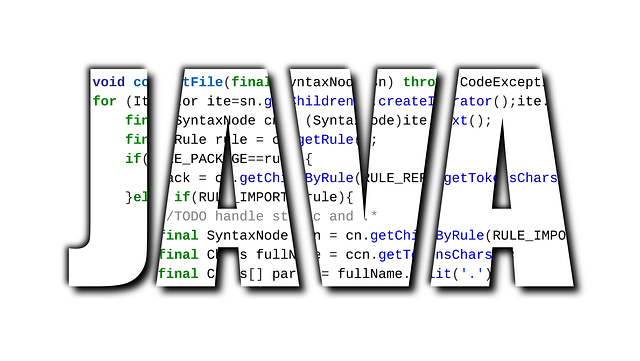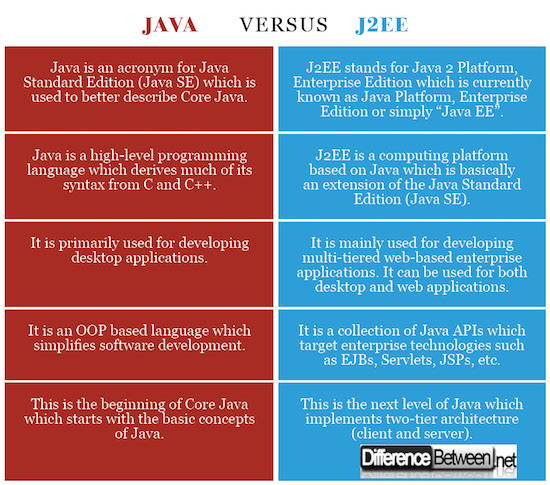Difference Between Java and J2EE
What is Java?

Java is basically everywhere – from web applications to websites, from laptops to datacenters, game consoles to supercomputers, from desktops to mobile phones, almost everywhere. Java is at the core of millions of devices throughout the world; in fact, almost every native Android application comes pre-built with Java. Java was initially conceived by James Gosling at Sun Microsystems in 1991 as a platform-independent language to create software to be embedded in consumer electronic devices such as remote controls, microwave, etc. The ideal was to develop an architecture-neutral language that would work on different environments on a variety of CPUs, which ultimately gave birth to Java. Over time, it has become one of the most sophisticated and powerful programming languages, which is still widely used today.
Java redefined the way we use a computer language and the evolution of internet has brought Java to the forefront of programming. The best part; it has fewer implementation dependencies compared to its predecessors, plus it’s cross-platform compatible which means it can be developed on any device, compiled into a standard bytecode which can run on all devices with Java Virtual Machine (JVM) pre-built, hence the phrase “Write once, Run anywhere”. The code is able to run on all JVM-compliant machines, thanks to its portability and ease of use. The bytecodes aren’t platform specific, so with the help of JVM, the program would run on any platform irrespective of the architecture.

What is J2EE?
This was originally known as Java 2 Platform, Enterprise Edition, which was later changed to Java Platform, Enterprise Edition (Java EE). This is one of the three computing platforms released by Sun Microsystems which was later acquired by Oracle Corporation. The other two platforms are Java Standard Edition (Java SE) and Java Micro Edition (Java ME). J2EE is nothing but an extension of the Java SE based on the Java programming language used for developing and deploying web-based enterprise applications. It consists of a set of APIs, services, and protocols that provide the functionality to develop multi-tiered web-based applications. It includes several technologies that extend the functionality of the Java SE APIs, such as Servlets, Connectors, Enterprise JavaBeans, etc.
It’s mainly used for applications which run on servers and accessible through browsers like Chrome, Firefox, etc. It’s also used for developing web applications over World Wide Web by creating standardized modular components to handle many aspects of programming. The J2EE architecture provides services to simplify the common challenges faced by developers while developing modern applications, thereby making it easier to implement industry-standard design patterns for greater efficiency and reliability. It is comprised of a significant set of APIs along with Java EE core technologies that help make the most of enterprise development. Simply speaking, J2EE is just a part of Java with a powerful set of libraries.
Difference between Java and J2EE
Terminology of Java and J2EE
Java is a tem given by Sun Microsystems to refer to the Java Standard Edition (Java SE). It’s a widely used programming language which derives much of its syntax from C and C++ with fewer implementation dependencies. J2EE, originally known as Java Enterprise Edition (Java EE), is a collection of Java APIs owned by Oracle Corporation used to write server-side enterprise applications.
Platform for Java and J2EE
Java is a high-level class-based programming language that is commonly used to develop and deliver content on the web. It’s a simplified version of C++ designed to run on all JVM-compliant platforms irrespective of the architecture. J2EE, on the other hand, is one of the core technologies of Java used for developing server applications such as websites and web applications.
Application of Java and J2EE
Java is robust and platform-independent, which means the compiled code can be executed on any platform running a Java Virtual Machine (JVM). It is write once and run anywhere language because of the bytecode which can run on different operating systems, making it a preferred choice for all kinds of platforms such as websites, servers, mobile phones, embedded systems, etc. J2EE, on the other hand, provides an architecture-neutral environment to develop large-scale enterprise applications.
Components in Java and J2EE
The three main components of Java language are Java Virtual Machine (JVM), Java Development Kit (JDK), and Java Runtime Environment (JRE). Each component works in conjunction with each other to simplify software development. J2EE, on the other hand, holds Servlets and JavaServer Pages (JSPs), along with Enterprise JavaBeans (EJBs) and Java Database Connectivity (JDBC).
Java vs. J2EE: Comparison Chart

Summary of Java vs. J2EE
Java is a general purpose programming language which is somewhat related to C++ which is in fact a direct descendant of the C language. Because much of the syntax of Java is inherited from C and C++, it would be wise to think of Java as an internet version of the C++. However, both share significant differences so comparing the two wouldn’t be a great idea either. Java wasn’t designed to replace C++, but to overcome the complexities of C++. It’s developed by Sun Microsystems which was later acquired by Oracle Corporation. Java Platform Enterprise Edition (Java EE), formerly known as J2EE, on other hand, is a standard for developing web-based server side applications online. It is a collection of Java APIs owned by Oracle with a powerful set of libraries that can be used to build enterprise applications.
- Difference Between Caucus and Primary - June 18, 2024
- Difference Between PPO and POS - May 30, 2024
- Difference Between RFID and NFC - May 28, 2024
Search DifferenceBetween.net :
Leave a Response
References :
[0]Image credit: https://upload.wikimedia.org/wikipedia/commons/c/c2/Telosys_Clients.PNG
[1]Image credit: https://pixabay.com/en/java-software-software-development-2327538/
[2]Gupta, Arun. Java EE 7 Essentials. Sebastopol: O'Reilly Media, 2013. Print
[3]Arnold, Kim, James Gosling, and David Holmes. The Java Programming Language. Boston: Addison-Wesley, 2006. Print
[4]Haggar, Peter. Practical Java: Programming Langauge Guide. Boston: Addison-Wesley, 2000. Print
